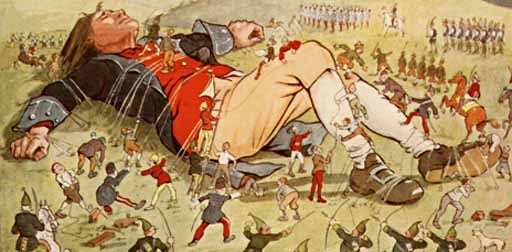Jonathan Swift’s Gulliver’s Travels presents a humorous yet potent contradiction to the tales and, more importantly, the messages related in Daniel Defoe’s Robinson Crusoe. The most striking difference Swift provides in the ways in which the individual and the society are presented: in the first chapter of A Voyage to Lilliput, Gulliver finds himself captured by the inhabitants and expresses his ambivalent sentiments:
“I confess I was often tempted, while they were passing backwards and forwards on my body, to seize forty or fifty of the first that came in my reach, and dash them against the ground. But the remembrance of what I had felt, which probably might not be the worst they could do, and the promise of honour I made them, for so I interpreted my submissive behaviour, soon drove out these imaginations. Besides, I not considered myself as bound by the laws of hospitality to a people who had treated me with so much expense and magnificence” (Swift 8).
Gulliver feels the fleeting desire to use his brute force as a far larger man to counter the inhabitants’ seizure of him, yet he ultimately acknowledges their dominion as a society, and furthermore, their unnecessary civility to a startling foreigner such as himself. It seems that Swift is mocking Defoe’s representation of Crusoe as an entitled Englishman by making his own protagonist a giant in comparison to the natives; in other words, Swift is paralleling his physically enormous protagonist to the enormous self-esteem of Defoe’s Crusoe. While the physical stature of Gulliver should render him the most powerful on the island, he defers to the power of the established order, which highlights the main difference between mentalities of Defoe and Swift. Unlike Defoe, Swift acknowledges the existing society as the ultimate wielder of power, and the individual – regardless of color, creed, or heritage – is automatically the submissive.
With this idea in mind, I’d like to draw your attention to the image I have included below (unfortunately I could not find the name of the illustrator). The image presents the very scene which is depicted in the previous passage, and most notable about this particular representation is the remarkable dichotomy between the individual and the larger legion of small men. Although Gulliver is extraordinarily bigger than the army that is taking him captive, he lays docile and submissive to the overtaking of his body. While Gulliver appears petrified, the society of small men appear active, powerful, and rather unfazed by the seemingly monstrous man they have found. This is an excellent depiction of Swift’s idea of the dominion of the society, and the reverence with which the individual should behave in its presence.



Grade comment:
While it could use more textual evidence and a clearer beginning/earlier presentation of the thesis, I thought the original idea, organized structure, and use of media accompaniment strengthened it.
This post was well-written and easy to follow. The idea presented in the second half of the post – that Swift seeks to emphasize the power of society over the individual – is original and thought-provoking, and was explained well by drawing comparisons between Robinson Crusoe and Gulliver’s Travels. The use of the image both supplemented and illuminated this idea further. Unfortunately, the first portion of the post was vague, and did not establish this thesis, and the excerpt from the text did not highlight the specific idea well. To improve this, I would add more textual support to the society vs. individual thesis. Great job overall – this was a great trigger for discussion in class on Thursday.
Too simple a contrast. I wish you continued your comparative analysis between the two authors deeply and reaching more chapters of both stories. What about the charming Rohrryhim? (mispelled, for sure)
But, mainly, what about a lot of “coincidences” between the two protagonists: a ‘mighty Destiny’ forces both to be led by a nomad life, full of maritime tragedies, they come back home but only to find their ‘mission’ in life is to go abroad again… Both came from a ordinary family and in some way or another became rich and/or famous, scornful of their Western-fellows, notwithstanding the brutes they meet with. And, apparently, both die in peace.